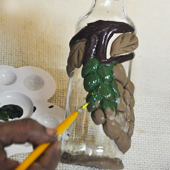Ceramic art involves the use of clay by artists to make models, Sculpture, and decorative objects such as bowls, cups, and jewelry. Clay can be of different colours depending on the minerals in the original rock; for example, high iron content can make clay red. Gray clay can create more dust, and breathing it in can be harmful. Artisans working with ceramics have steadily contributed to the art world for centuries. "Ceramics is a medium that, with every passing decade, becomes easier for the untrained to manipulate rampant, versatile, and demystified, and perhaps more worthy of a clarified position within the wider history of sculpture," says the British ceramist Aaron Angell, who set up a pottery studio in London in 2014 to teach fellow artists. The earliest ceramics made by humans were pottery objects (i.e., pots or vessels) or figurines made from clay, either by itself or mixed with other materials like silica, hardened, sintered, in the fire. Later ceramics were glazed and fired to create smooth, coloured surfaces, decreasing porosity through the use of glassy, amorphous ceramic coatings on top of the crystalline ceramic substrates.
Ceramic art is one of the arts, particularly the visual arts. Of these, it is one of the plastic arts. While some ceramics are considered fine art, some are considered to be decorative, industrial, or applied art objects. Ceramics may also be considered artifacts in archaeology. Ceramic art can be made by one person or by a group of people. A group of people designs, manufactures, and decorates the art ware in pottery or ceramic factory. Working with clay involves consideration of surface, form, structure, and decoration. Various techniques, including pinching, rolling the clay into coils, making slabs, and joining, can be explored to make ceramic objects.




